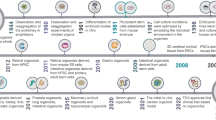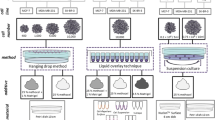Abstract
This study is aimed at isolating colorectal cancer stem-like cells in vitro using a neurosphere assay method employed in isolating gliobastoma multiforme tumor cells. This was followed with confirmation of the isolated cells by flow cytometry, pluripotent genes expression and in vivo tumorigenicity assay. Using this culture assay, stem-like and non-stem-like CRC cells were isolated and expanded in vitro from purchased Balb/c mice induced with CT26 colorectal cancer (CRC) cell line. The procedure includes an initial mechanical dissociation and chemical digestion of tumor tissue and subsequently plating the resulting single cell suspension in serum-free medium (SFM) or serum-containing medium (SCM). This selectively permits growth of cancer stem-like cells in SFM and eliminates non-stem-like cancer cells through the process of anoikis or apoptosis. CRC stem cells derived cultures proliferated as non-adherent spheres in vitro in different shapes and sizes. These cells expressed cell surface markers previously reported for tumor stem cells, including CD44, CD133, CD166 and CD26 and formed tumors when implanted in severe combined immunodeficient mice in a concentration dependent manner. Importantly, the stem-like cells had self-renewal properties with significantly higher expression of the pluripotent stem cell genes NANOG, OCT4, and SOX2 compared to the adherent non-stem cells. Collectively, the results of this study indicate that SFM is a defined culture medium that enriches for CRC stem-like cells and represents a suitable in vitro model for the study of CRC stem-like cells. This finding may be useful in developing therapeutic strategies aimed at eradicating the tumorigenic subpopulation within colorectal cancer.






Similar content being viewed by others
References
Amini S, Fathi F, Mobalegi J, Sofimajidpour H, Ghadimi T (2014) The expressions of stem cell markers: Oct4, Nanog, Sox2, nucleostemin, Bmi, Zfx, Tcl1, Tbx3, Dppa4, and Esrrb in bladder, colon, and prostate cancer, and certain cancer cell lines. Anat Cell Biol 47:1–11
Anderson EC, Hessman C, Levin TG, Monroe MM, Wong MH (2011) The role of colorectal cancer stem cells in metastatic disease and therapeutic response. Cancers 3:319–339. doi:10.3390/cancers3010319
Azari H, Millette S, Ansari S, Rahman M, Deleyrolle LP, Reynolds BA (2011) Isolation and expansion of human glioblastoma multiforme tumor cells using the neurosphere assay. J Vis Exp 30:e3633. doi:10.3791/3633
Bass AJ, Watanabe H, Mermel CH, Yu S, Perner S, Verhaak RG, Kim SY, Wardwell L, Tamayo P, Gat-Viks I, Ramos AH, Woo MS, Weir BA, Getz G, Beroukhim R, O’Kelly M, Dutt A, Rozenblatt-Rosen O, Dziunycz P, Komisarof J, Chirieac LR, Lafargue CJ, Scheble V, Wilbertz T, Ma C, Rao S, Nakagawa H, Stairs DB, Lin L, Giordano TJ, Wagner P, Minna JD, Gazdar AF, Zhu CQ, Brose MS, Cecconello I, Jr UR, Marie SK, Dahl O, Shivdasani RA, Tsao MS, Rubin MA, Wong KK, Regev A, Hahn WC, Beer DG, Rustgi AK, Meyerson M (2009) SOX2 is an amplified lineage-survival oncogene in lung and esophageal squamous cell carcinomas. Nat Genet 41:1238–1242
Blanpain C, Horsley V, Fuchs E (2007) Epithelial stem cells: turning over new leaves. Cell 128:445–458
Boman BM, Huang E (2008) Human colon cancer stem cells: a new paradigm in gastrointestinal oncology. J Clin Oncol 26:2828–2838. doi:10.1200/JCO.2008.17.6941
Buczacki S, Davies RJ, Winton DJ (2011) Stem cells, quiescence and rectal carcinoma: an unexplored relationship and potential therapeutic target. Br J Cancer 105:1253–1259. doi:10.1038/bjc.2011.362
Chen KL, Pan F, Jiang H, Chen JF, Pei L, Xie FW, Liang HJ (2011) Highly enriched CD133+ CD44+ stem-like cells with CD133+ CD44 high metastatic subset in HCT116 colon cancer cells. Clin Exp Metastasis 28:751–763. doi:10.1007/s10585-011-9407-7
Clarke MF, Dick JE, Dirks PB, Eaves CJ, Jamieson CH, Jones DL, Visvader J, Weissman IL, Wahl GM (2006) Cancer stem cells–perspectives on current status and future directions: AACR Workshop on cancer stem cells. Cancer Res 66:9339–9344
Dalerba P, Cho RW, Clarke MF (2007a) Cancer stem cells: models and concepts. Annu Rev Med 58:267–284
Dalerba P, Dylla SJ, Park IK, Liu R, Wang X, Cho RW, Hoey T, Gurney A, Huang EH, Simeone DM, Shelton AA, Parmiani G, Castelli C, Clarke MF (2007b) Phenotypic characterization of human colorectal cancer stem cells. Proc Natl Acad Sci USA 104:10158–10163
Du L, Wang H, He L, Zhang J, Ni B, Wang X, Jin H, Cahuzac N, Mehrpour M, Lu Y, Chen Q (2008) CD44 is of functional importance for colorectal cancer stem cells. Clin Cancer Res 14:6751–6760
Elrick LJ, Jorgensen HG, Mountford JC, Holyoake TL (2005) Punish the parent not the progeny. Blood 105:1862–1866
Fialkow PJ (1976) Clonal origin of human tumors. Biochim Biophys Acta 458:283–321
GLOBOCAN Statistics (2012) Estimated cancer incidence mortality and prevalence worldwide in 2012. http://globocan.iarc.fr/Pages/fact_sheets_cancer.aspx. Accessed 25 Sept 2014
Ji J, Zheng PS (2010) Expression of Sox2 in human cervical carcinogenesis. Hum Pathol 41:1438–1447
Keysar SB, Jimeno A (2010) More than markers: biological significance of cancer stem cell-defining molecules. Mol Cancer Ther 9:2450–2457
Levin TG, Powell AE, Davies PS, Silk AD, Dismuke AD, Anderson EC, Swain JR, Wong MH (2010) Characterization of the intestinal cancer stem cell marker CD166 in the human and mouse gastrointestinal tract. Gastroenterology 139:2072–2082. doi:10.1053/j.gastro.2010.08.053
Lynch HT, Smyrk T (1996) Hereditary nonpolyposis colorectal cancer (Lynch syndrome). An updated review. Cancer 78:1149–1167
Meng HM, Zheng P, Wang XY, Liu C, Sui HM, Wu SJ, Zhou J, Ding YQ, Li J (2010) Overexpression of nanog predicts tumor progression and poor prognosis in colorectal cancer. Cancer Biol Ther 9:295–302. doi:10.4161/cbt.9.4.10666
Mizrak D, Brittan M, Alison M (2008) CD133: molecule of the moment. J Pathol 214:3–9
O’Brien CA, Pollett A, Gallinger S, Dick JE (2007) A human colon cancer cell capable of initiating tumour growth in immunodeficient mice. Nature 445:106–110
Pang R, Law WL, Chu AC, Poon JT, Lam CS, Chow AK, Ng L, Cheung LW, Lan XR, Lan HY, Tan VP, Yau TC, Poon RT, Wong BC (2010) A subpopulation of CD26+ cancer stem cells with metastatic capacity in human colorectal cancer. Cell Stem Cell 6:603–615
Puglisi MA, Tesori V, Lattanzi W, Gasbarrini GB, Gasbarrini A (2013) Colon cancer stem cells: controversies and perspectives. World J Gastroenterol 19:2997–3006
Ricci-Vitiani L, Lombardi DG, Pilozzi E, Biffoni M, Todaro M, Peschle C, De Maria R (2007) Identification and expansion of human colon-cancer-initiating cells. Nature 445:111–115
Sanders MA, Majumdar AP (2011) Colon cancer stem cells: implications in carcinogenesis. Front Biosci 16:1651–1662
Santagata S, Ligon KL, Hornick JL (2007) Embryonic stem cell transcription factor signatures in the diagnosis of primary and metastatic germ cell tumors. Am J Surg Pathol 31:836–845
Sholl LM, Barletta JA, Yeap BY, Chirieac LR, Hornick JL (2010) Sox2 protein expression is an independent poor prognostic indicator in stage I lung adenocarcinoma. Am J Surg Pathol 34:1193–1198
Snippert HJ, van Es JH, van den Born M, Begthel H, Stange DE, Barker N, Clevers H (2009) Prominin-1/CD133 marks stem cells and early progenitors in mouse small intestine. Gastroenterology 136:2187–2194
Vlashi E, McBride WH, Pajonk F (2009) Radiation responses of cancer stem cells. J Cell Biochem 108:339–342
Vogelstein B, Fearon ER, Hamilton SR, Feinberg AP (1985) Use of restriction fragment length polymorphisms to determine the clonal origin of human tumors. Science 227:642–645
Yang H, Qu F, Myers RE, Bao G, Hyslop T, Hu G, Fei F, Xing J (2012) Genetic variations in stem cell-related genes and colorectal cancer prognosis. J Gastrointest Cancer 43:584–593
Zbinden M, Duquet A, Lorente-Trigos A, Ngwabyt SN, Borges I, Ruiz i Altaba A (2010) NANOG regulates glioma stem cells and is essential in vivo acting in a cross-functional network with GLI1 and p53. EMBO J 29:2659–2674
Zhang J, Li YL, Zhou CY, Hu YT, Chen HZ (2010a) Expression of octamer-4 in serous and mucinous ovarian carcinoma. J Clin Pathol 63:879–883
Zhang X, Yu H, Yang Y, Zhu R, Bai J, Peng Z, He Y, Chen L, Chen W, Fang D, Bian X, Wang R (2010b) SOX2 in gastric carcinoma, but not Hath1, is related to patients’ clinicopathological features and prognosis. J Gastrointest Surg 14:1220–1226
Zhu L, Gibson P, Currle DS, Tong Y, Richardson RJ, Bayazitov IT, Poppleton H, Zakharenko S, Ellison DW, Gilbertson RJ (2009) Prominin 1 marks intestinal stem cells that are susceptible to neoplastic transformation. Nature 457:603–607
Acknowledgments
This study is funded by Tianjin science and technology commission of science and technology projects. Project No: 12ZCDZSY16800. The authors wish to extend profound gratitude to Li Wen and Li Shan Shan for their tremendous support.
Conflict of interest
The authors declare no conflict of interest.
Author information
Authors and Affiliations
Corresponding author
Rights and permissions
About this article
Cite this article
Dotse, E., Bian, Y. Isolation of colorectal cancer stem-like cells. Cytotechnology 68, 609–619 (2016). https://doi.org/10.1007/s10616-014-9806-0
Received:
Accepted:
Published:
Issue Date:
DOI: https://doi.org/10.1007/s10616-014-9806-0




